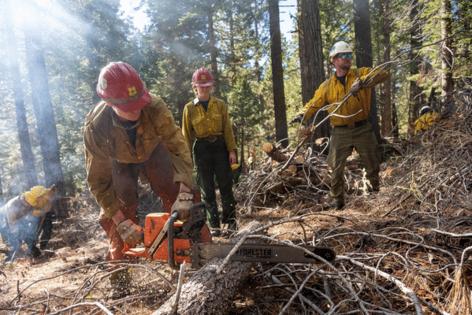Tom Philp: California thins its forests, then burns the wood. Is there a better idea?
Published in Op Eds
In California’s never-ending effort to thin its forests to prevent devastating wildfires, crews are removing millions of tons of small trees and brush every year.
And then most of it goes up in smoke. It is burned, in controlled and intentionally lit fires, before the next fire season.
The search for a better solution has been elusive. One proposal to convert much of this biomass into wood pellets, and ship them overseas from Stockton to be burned halfway around the world, drew widespread criticism from environmental groups.
This opposition, combined with a worldwide drop in price for these wood pellets, has rural counties rethinking how to create something of market value out of all this material rather than to simply burn it. The new idea is to somehow convert the so-called “biomass” here in California.
“We don’t have an outlet for the biomass,” said Patrick Blacklock, president of the Rural County Representatives of California (RCRC). This coalition of 40 counties, which represents more than 62% of the state but less than 15% of its population, has been at the front lines of California’s ongoing wildfire wars.
The basic goal here is to repurpose all this wooden material in a way that pencils out and also in the most environmentally benign manner possible. Burning wood pellets isn’t that much better than burning the same material in piles back in the forest. California is going to try to do better. But the state may need some technological breakthrough to make it happen.
These 40 disparate counties have been pooling their resources for advocacy and shared challenges for more than 50 years. It was the worsening condition of California’s forests, with thickets of small trees due to decades of fire suppression, that prompted RCRC to create in 2019 a non-profit spinoff known as Golden State Natural Resources (GSNR) to look for new markets for the remnants of forest thinnings that are too small to convert into lumber products.
As just one example, the Stanislaus National Forest spans nearly 900,000 acres in four counties (Tuolumne, Alpine, Mariposa and Calaveras). There are an estimated 50,000 different piles of biomass from thinning operations now sitting on the forest floor.
“All of those piles are simply being burned out in the forest, with no public benefit other than the reduction of fuel if a wildfire should burn through the area in the future,” said John Buckley, a long-time activist promoting forest health as executive director of the Central Sierra Environmental Resource Center.
At first, Buckley and an impressive array of organizations were opposed to GSNR’s first idea, which was to build two facilities to turn the biomass into pellets and to ship it somewhere overseas. GSNR had begun the environmental review for this project in concert with a private firm. Environmental groups objected to burning all this carbon, while Stockton organizations objected to thousands of additional train cars bringing a million tons of wood pellets through their port annually.
And then the economics of the whole idea turned south. Worldwide, there has been an “exponential growth in supply….primarily from Vietnam,” Blacklock said. So the industry isn’t nearly as lucrative as before. And GSNR decided it would be better to have at least some environmental stakeholders supporting them rather than the united opposition facing the pellet idea.
GSNR is looking at three potential options, to convert biomass either into aviation fuel, hydrogen and electricity “with a carbon capture component,” Blacklock said. Each option requires wood chips as opposed to pellets, and Blacklock is hoping that one of these options will emerge as achievable within a decade. “We’re at a very pivotal point here,” he said.
These thinning projects are pulling a lot of carbon material out of California forests in this biomass, and it makes sense to emit as little of this as possible. But unless it’s going to rain money from the sky, whatever the reuse has to be marketable as well.
“Focusing on how to take a waste project, to convert waste wood into wood chips, and to send them by rail to markets in California and adjacent states is a huge improvement,” Buckley said. “This new plan is far more balanced and realistic.”
California could desperately use a success story in our threatened forests. It feels like we’re one innovation away from making the most out of the wood chip.
_____
©2025 The Sacramento Bee. Visit sacbee.com. Distributed by Tribune Content Agency, LLC.

























































Comments